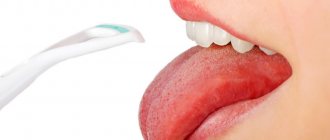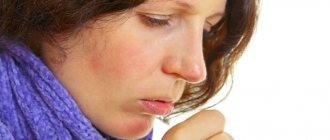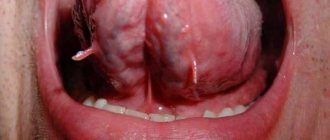Causes of the disease
The culprit of condylomas is the human papillomavirus. In a carrier of the virus, neoplasms most often appear in the genital area, but can also be localized in the form of growths in the oral cavity.
HPV is an incurable disease that, once it enters the body, remains there forever. You can become infected with the virus that causes condylomas on the tongue in two ways:
- From mother to child (in the womb or when passing through the reproductive tract during childbirth).
- Sexually (vaginal, oral sex).
Infectious agents of the virus can remain latent in the human body for years, waiting for an opportunity to become active. The main reason contributing to the entry of the disease into the active phase and its development is a decrease in immunity. In addition to a general decrease in the body's defenses, provoking factors can be:
- decreased local immunity of the oral cavity (stomatitis, pharyngitis, tonsillitis);
- bad habits: smoking and alcohol abuse;
- local hypothermia (for example, with excessive consumption of ice cream).
At this time, genital and flat condylomas appear on the genitals and oral mucosa.
Condylomas acuminata - symptoms and treatment
The key point in the pathogenesis of the disease is the penetration of HPV into the host body. With a single sexual contact, the probability of infection is 80%, then, with a good state of the immune system, infectious agents are eliminated (destroyed).
Viruses of various types are adapted to a specific host. There are hundreds of types of viruses, many of them are not dangerous to humans, since they are tropic to the tissues of mammals, reptiles and birds and cause benign tumors in them (formation of papillomas).[3]
When studying HPV, three types of viruses were identified - alpha, beta, gamma. Of these, anogenital lesions are caused by papillomaviruses of the first group (α). Infectious agents belonging to the Beta and Gamma genera are more often found with papillomas of the keratinizing epithelium [3] - plantar and palmar warts appear.
In genera, when classifying viruses, types (genotypes) were identified. They are indicated by Arabic numerals. Of the hundreds of virion genotypes, particles with a high carcinogenic risk are isolated - these are α 16, 18, 31, 33, 35, 39, 45, 51, 52, 56, 58, 59. They are detected in 90-95% of cases with malignant processes of the cervix , vagina and vulva. Types 16 and 18 are especially significant. Such oncogenic types of HPV, containing E6 and E7 proteins in their DNA, are able to suppress the activity of the tumor suppressor proteins p53 and pRb, leading to the rapid malignant transformation of papillomas into carcinomas.
About 90% of cases of anogenital warts are caused by HPV α 6 and 11. These are pathogens of low carcinogenic risk.[5] This same low-risk group includes HPV 40, 42, 43, 44, 54, 61, 72, 81.
Penetration
Virions penetrate the basal layer of the epithelium through microscopic damage and then attach to cell membrane proteins. Next, they engage the mechanism of receptor endocytosis (with the participation of integrin and L1 protein from the viral capsid) and enter the cytoplasm. The L2 protein from the viral capsid promotes the release of viral DNA and its entry into the nucleus.[5]
Reproduction
Proteins E1 and E2 from the DNA of the virus are involved in the replication of the foreign genome in the nucleus of the affected cell. At the same time, the cell retains the ability to divide and reproduce its own DNA. By multiplying its DNA, the virus ensures its presence in the form of episomes in the cytoplasm (about 100 per cell). This joint “work” of the virus and the host cell leads to a failure in the processes of proliferation (cell reproduction) and differentiation in the basal layer, leading to visual manifestations.
Manifestations
Abnormal endophytic or exophytic growths of the epithelium appear - papillomas, spots or condylomas. Loose mucous membrane or atypical epithelium of outgrowths are prone to rapid traumatization and maceration (softening). Against this background, a secondary infection quickly develops, pain, discomfort, copious discharge, inflammation, swelling, unpleasant odor, and ulceration of condylomas appear.[2][3]
In the cells of the basal layer, active replication of the virus occurs; as condyloma cells differentiate, their blood supply is sharply depleted, and the central vessels are reduced. But, remaining in the upper layers of the epithelium in an inactive form, this is where the virus is dangerous in terms of contact infection.
During histoanalysis of biopsy materials, the epithelium is thickened, areas of acanthosis and papillomatosis are revealed. Koilocytes are detected (changed in size cells with light cytoplasm, many vacuoles, and a perinuclear light rim). Their nuclei are hyperchromatic. Cells with two or more nuclei are often found.[8]
From the above we can conclude: viruses that cause the formation of anogenital warts, in 90% of cases, belong to types α 6 and 11 HPV.[6][7] They have a low probability of causing malignancy (cancerous degeneration). However, there are frequent cases of joint persistence (residence) of viruses of different types in one carrier. This obliges the patient and doctor to be especially attentive to preventive examinations, their quality and regularity to prevent anorectal cancer .
Symptoms of papillomavirus infection
When the virus is activated, a person experiences rapid growth of papillomas - this is the main sign of HPV manifestation. Neoplasms that arise on the oral mucosa can be localized on the tongue, palate, inner surface of the cheeks, and border of the lips.
Depending on the type of disease, the formations can be flat or pointed. Flat tumors often appear on the lateral edges of the tongue. They do not rise above the fabrics and have a round shape. On and under the tongue, genital warts appear - soft white or pink growths on a stalk measuring 1-6 mm.
In conditions of intensive growth, genital warts may appear too quickly next to each other, thereby grouping and forming conglomerates (looking like cauliflower). But most often, formations in the oral cavity occur in patches, that is, a small number of pointed growths.
The appearance of papillomas is accompanied by unpleasant sensations. Warts on and under the tongue can be painful because the tongue is involved in processing food. And constant mechanical impact on papillomas traumatizes them and can cause discomfort: pain, itching, burning and bleeding. In addition, condylomas on the oral mucosa can make speech difficult.
Along with pointed neoplasms on the tongue, papillomas may occur in the pharynx and larynx. Being constantly injured by food, such growths begin to hurt and bleed. Under these conditions, a bacterial or fungal infection may join the virus. A person develops a dry cough and scratching pain in the throat.
Are condylomas dangerous?
Unfortunately, despite the seeming harmlessness of condylomas, they are very dangerous. In fact, the processes occurring in the growing tissue of viral condylomas are akin to the processes occurring in the tumor. Therefore, perineal condylomatosis can be classified as a precancerous condition. Medical studies have proven that the presence of cervical condylomas increases the risk of cancer by 50 (fifty!) times. In addition, condylomas can be injured by friction against clothing, ulcerate, become inflamed and bleed, interfere with normal sexual life, and cause aesthetic and psychological discomfort. In addition to condylomas, human papillomavirus leads to the formation of papillomas of various types, among which are simple papilloma (usually localized on the fingers and knees of children), plantar papilloma, flat papillomas (usually on the face and hands), filamentous papilloma (more often affects older people) from 40 years).
Diagnosis of the disease
Before diagnosis, it is important to figure out which doctor to go to to treat genital or flat condylomas in the mouth. Since such growths form on the oral mucosa, and the presence of condylomas in the pharynx and larynx may also be observed, you should consult an otolaryngologist, dentist or dermatovenerologist. After examining the surface of the epithelium, the doctor will prescribe a PCR test. With its help, not only the presence of HPV in the body is determined, but also its type.
Some types of the disease are characterized by the degeneration of genital warts into malignant formations (if the virus is not treated). Therefore, diagnosis and treatment of HPV must be done on time.
If necessary, to determine the malignant nature of condyloma on the tongue, a histological examination of its tissue is prescribed.
Types of neoplasms (pointed, flat)
A number of types of papilloma are found in the oral cavity, these are:
- Epithelial hyperplasia . This type is expressed by the appearance of small growths, their color is red, and upon palpation they are felt as tender and mobile formations. They are localized mainly on the lateral surfaces of the tongue.
- Vulgar or elementary papilloma . The growth has a pineal configuration with a thin base; this disease is mobile and often increases in the soft palate.
- Flat papillomas mostly occur on the gums. Their surface is granular, and the color matches the red color of the mucous membrane.
- Thread-like papillomas have a thin stalk and are easily injured.
- Genital warts appear if the infection occurs through sexual contact. These growths are characterized by the unification and formation of a large tumor with an uneven tuberculate surface.
How to remove condylomas in the mouth
Removing pointed growths involves:
- laser removal;
- radio wave method;
- cryodestruction;
- medications;
- traditional methods.
Genital warts under the tongue and on its surface should be removed only after their appearance and growth have stopped, and treatment should be carried out in combination with general strengthening of the body and giving up bad habits. In another case, the appearance of genital warts threatens the risk of constant relapses.
Elimination of such tumors does not cause severe discomfort and is not difficult. The surface of the epithelium in the mouth does not bleed after surgery and heals quickly, and opening the internal tissues is not required. The removal method is selected depending on the individual characteristics of the organism, the degree of distribution of pointed growths, location and their size.
Laser removal
Genital warts in the mouth can be eliminated using a laser. The laser removal procedure is a painless method. With it, genital papillomas disappear under the influence of a laser directed at them. In this case, the beam is directed directly to genital warts and does not damage surrounding tissue.
The operation is distinguished by the high speed of the procedure, the absence of complications, swelling and scars after it. In addition, the laser beam has an antibacterial effect, which prevents infection from entering the wound. The only disadvantage of laser removal is the high cost.
Radio wave therapy
This therapy is one of the more affordable methods of treating condylomas on the tongue. During the operation, genital warts are cut out with a radio knife. After removing condylomas in the mouth, the wounds do not bleed and heal quickly, and the removal itself takes a few minutes and does not cause pain.
The advantage of radio wave therapy over laser therapy is that the removed papilloma, after cutting with a knife, can be sent for histological examination. The laser evaporates the growth in layers and does not provide the opportunity to take a tissue sample.
Cryodestruction
Removing condylomas in the mouth using cryodestruction involves freezing them. During the procedure, the neoplasm tissue is exposed to liquid cold nitrogen. They freeze and die. The cryodestruction method is indicated when a large surface of the tongue is affected by pathological neoplasms.
However, freezing has a number of disadvantages. This operation causes swelling and has a long recovery period. After this, it is impossible to take a tissue sample for histological examination. With this removal method, it is difficult to control the depth of papilloma freezing. Those. after surgery, it may not be completely destroyed, which entails the need for a repeat procedure.
How to eliminate an infection with medications
During an exacerbation of HPV, drug therapy is suggested that can transfer the virus into a latent state. For this purpose, antiviral, immunomodulating drugs, and vitamin complexes are prescribed. During treatment, local antiviral and antibacterial drugs are also used.
Medicines must be used with extreme caution and only as prescribed by a doctor, since contact of a caustic solution with healthy tissue can cause a burn.
Treatment of condyloma in the mouth can be carried out with local pharmaceutical preparations, the chemical composition of which can destroy the formations by cauterization.
Folk remedies
Preparations based on natural ingredients are suitable only for single warts on the tongue. For this you can use:
- garlic;
- egg white;
- Castor oil;
- juice from a dandelion stem.
Any of these products should be used to rub the ridged growths daily. The development of the inflammatory process will be prevented by rinsing with decoctions of chamomile, string, and sage.
Treatment options
To get rid of condylomas, it is necessary not only to act on the warts themselves. An important step is to stop the activity of HPV.
The process of treating the disease is as follows:
- taking antiviral drugs.
- Complete dental treatment (plaque removal, caries therapy, etc.).
- Using ointments and gels to fight the virus.
- Careful oral hygiene, rinsing with special solutions.
- Strengthening the immune system with drugs and other methods (healthy lifestyle, proper nutrition, etc.).
- Additional vitamin therapy.
- Mechanical removal of growths.
During the period of exacerbation of pathology, you should pay special attention to the oral cavity, excluding the ingress of spicy, as well as excessively cold or hot food and drinks.
Drug therapy
Medicines are selected based on the clinical picture of the disease. Typically the patient is prescribed the following medications:
- “Cycloferon”, “Isoprinosine”, etc. - any immunomodulator.
- "Panavir" - as an antiviral agent.
- "Prospidin" - controls the virus, stopping the division of pathogenic cells.
Not all medicines available in pharmacies are suitable for use on mucous membranes, so the selection of medicines should be carried out by a specialist.
In addition to the above, Malavit may be prescribed for condylomas. The product has a completely natural composition, which makes it suitable for use on the skin and mucous membranes. The effect of the medicine is as follows:
- relieves pain.
- Relieves swelling.
- Eliminates itching.
- Destroys bacteria.
The drug is not addictive and can be used in combination with other treatment methods.
Removal
If conservative treatment does not bring the expected result, warts on the tongue are subjected to mechanical stress. Removal of condylomas in the oral cavity is carried out in various ways:
- Cryodestruction (freezing papules with liquid nitrogen).
It has minimal pain. Exposure to low temperatures prevents bleeding of wounds. Cryodestruction is rarely used to remove tumors on the mucous membranes due to the low accuracy of the manipulations performed. Sometimes repeated freezing is required, and scars remain on the surface of the mucosa.
- Laser therapy.
The risk of bleeding is eliminated and the level of pain is also minimized.
- Electrocoagulation.
The procedure of applying direct electric current to excess tissue. Discomfort from electrical destruction is minimal, and scars may remain.
- Laser removal by radio wave.
Exposure of tissue to radio waves of different lengths is the best way to remove tumors on the tongue. The equipment does not come into direct contact with the affected area. The likelihood of scars on the mucous membrane is reduced to zero.
- Excision of growths with a surgical scalpel.
This method is recommended if the condyloma is too large. The procedure is painful and is performed under local anesthesia. Usually small scars remain.
To make the wounds heal faster, the specialist will prescribe Imudon or any other similar drug. The lesions are treated with Solcoseryl dental adhesive paste.
Folk remedies
Treatment of condylomatosis is not limited only to medications. A positive effect can be achieved by using traditional medicine. Here are some recipes:
- treat condylomas with fresh garlic juice (or cut the clove into two parts and apply to the growths). Side effect is unpleasant taste and smell.
- Egg white is applied to fresh single papillomas. Systematic treatment will speed up healing.
- Rinse the affected area daily with a decoction of herbs (sage, chamomile, string). This will help prevent the inflammatory process.
- Apply castor oil to the warts generously.
- Apply walnut alcohol tincture to condylomas. To prepare, you will need the green peel of the fruit, which is poured with alcohol and left for 14 days away from light and heat. Condylomas must be treated carefully, without affecting healthy areas.
Any folk remedies for the treatment of condylomas in the oral cavity should be used only in conjunction with traditional methods. Before use, you should consult your doctor.
What will happen if left untreated?
If HPV is not treated, the number of genital warts may increase, negatively affect diction, and complicate eating. It is also necessary to remove genital warts in the mouth and lips because they can transform into malignant tumors in the mouth, subjected to constant mechanical stress and injury. Also, when injured, papillomas can fester, fall off and form bleeding wounds, thereby allowing bacterial infection into the body.
Removal
In almost all types of condylomatosis, there is a need to remove growths. The most widely used method is the radio wave method, which involves minimal trauma to the mucous membrane and dermatological surfaces.
In addition, in many patients, condylomas are removed using a laser, cryodestruction (liquid nitrogen), and less often by simple surgery.
Under no circumstances should you try to independently eliminate condylomas on the lips, tongue, or other parts of the oral cavity; such a procedure should be carried out by a doctor in a hospital setting.
Advantages of radio wave surgery using the Surgitron device
Doctors at the ProfMedLab clinic remove genital warts using the modern Surgitron radio wave surgery device. The principle of the method is that the device generates high frequency radio waves. Coming into contact with tissues, they evaporate liquid from cells, that is, they actually destroy them. Radio wave surgery has some advantages:
- Purposeful action. Only affected tissues are destroyed, while surrounding healthy tissues remain untouched. In this regard, radio wave surgery is a more gentle method compared to laser.
- Good cosmetic effect. After removal of tumors using the Surgitron apparatus, barely noticeable scars remain.
- Full control over the process. The surgeon can precisely control the area and depth of tissue removed.
- Bloodless intervention. There is no bleeding during genital wart removal.
- Fast recovery. The wound heals completely within a few days. There is virtually no pain or swelling.
Clinical picture
During the active growth phase, itching and burning may occur.
The main (in most cases the only) symptom of condyloma on the tongue is the neoplasm itself or a group of them formed in this area. However, during their active growth phase or after its completion, these tumors can cause discomfort due to itching or burning sensation. This is especially true in the case of damage to the tongue due to its mobility and active participation in chewing food, swallowing it, and also during conversation.
Condylomas under the tongue pose an additional danger, since their appearance often goes unnoticed until the infection spreads throughout the entire oral cavity. The appearance of condylomas can be described by a number of their distinctive features, on the basis of which the doctor will be able to make a differential diagnosis:
- look like tumor-like processes, reminiscent of cauliflower or a rooster's comb when growing;
- protrude above the surface of the tongue;
- have a thin stalk, less often – a wide base;
- can be of different sizes: from a small spot with small outgrowths to an extensive tumor;
- are painless, uniformly pink with a pronounced red border;
- are located unevenly.
Histological examination reveals a tree-like structure of condyloma, whose surface consists of many layers of squamous epithelium with signs of acanthosis, parakeratosis and papillomatosis. Also on the surface of these formations are found koilocytes - cells with deformed nuclei.
During periods of active growth, temperatures may rise.
Note! During the period of active growth of condyloma on the tongue, some people experience a slight deterioration in their general condition, up to weakness and fever, as with a typical infectious disease. With the end of tumor growth, such signs disappear.









